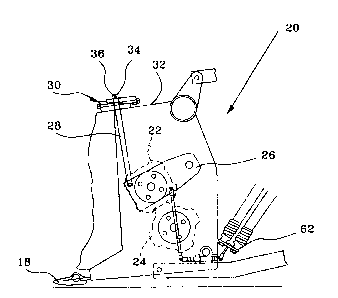Some of the information on this Web page has been provided by external sources. The Government of Canada is not responsible for the accuracy, reliability or currency of the information supplied by external sources. Users wishing to rely upon this information should consult directly with the source of the information. Content provided by external sources is not subject to official languages, privacy and accessibility requirements.
Any discrepancies in the text and image of the Claims and Abstract are due to differing posting times. Text of the Claims and Abstract are posted:
| (12) Patent: | (11) CA 2409473 |
|---|---|
| (54) English Title: | MOWER-CONDITIONER |
| (54) French Title: | FAUCHEUSE-CONDITIONNEUSE |
| Status: | Expired and beyond the Period of Reversal |
| (51) International Patent Classification (IPC): |
|
|---|---|
| (72) Inventors : |
|
| (73) Owners : |
|
| (71) Applicants : |
|
| (74) Agent: | BORDEN LADNER GERVAIS LLP |
| (74) Associate agent: | |
| (45) Issued: | 2006-07-11 |
| (22) Filed Date: | 2002-10-23 |
| (41) Open to Public Inspection: | 2003-04-30 |
| Examination requested: | 2002-10-23 |
| Availability of licence: | N/A |
| Dedicated to the Public: | N/A |
| (25) Language of filing: | English |
| Patent Cooperation Treaty (PCT): | No |
|---|
| (30) Application Priority Data: | ||||||
|---|---|---|---|---|---|---|
|
A mower conditioner includes upper and lower conditioner rolls with the upper
roll extending between, and being rotatably mounted to, a pair of vertically
swingable
arms. A linkage arrangement is coupled between the frame supporting the arms
and
the arms, with one part of the linkage being associated with a stop for
limiting the
range of movement of the upper roll toward the lower roll, and with another
part of the
linkage being coupled to a spring arrangement for biasing the upper roll
toward the
lower roll. The stop is configured as a pair of wedge-shaped members having
respective inclined surfaces engaged with each other and held in an adjusted
position
by a nut and bolt arrangement, the range of movement of the upper roll toward
the
lower roll changing in response to tightening or loosening the nut on the
bolt.
Note: Claims are shown in the official language in which they were submitted.
Note: Descriptions are shown in the official language in which they were submitted.

2024-08-01:As part of the Next Generation Patents (NGP) transition, the Canadian Patents Database (CPD) now contains a more detailed Event History, which replicates the Event Log of our new back-office solution.
Please note that "Inactive:" events refers to events no longer in use in our new back-office solution.
For a clearer understanding of the status of the application/patent presented on this page, the site Disclaimer , as well as the definitions for Patent , Event History , Maintenance Fee and Payment History should be consulted.
| Description | Date |
|---|---|
| Time Limit for Reversal Expired | 2010-10-25 |
| Letter Sent | 2009-10-23 |
| Grant by Issuance | 2006-07-11 |
| Inactive: Cover page published | 2006-07-10 |
| Pre-grant | 2006-04-24 |
| Inactive: Final fee received | 2006-04-24 |
| Inactive: IPC from MCD | 2006-03-12 |
| Notice of Allowance is Issued | 2005-11-02 |
| Letter Sent | 2005-11-02 |
| Notice of Allowance is Issued | 2005-11-02 |
| Inactive: Approved for allowance (AFA) | 2005-10-24 |
| Amendment Received - Voluntary Amendment | 2005-06-27 |
| Inactive: S.30(2) Rules - Examiner requisition | 2005-01-10 |
| Inactive: S.29 Rules - Examiner requisition | 2005-01-10 |
| Application Published (Open to Public Inspection) | 2003-04-30 |
| Inactive: Cover page published | 2003-04-29 |
| Inactive: First IPC assigned | 2003-01-16 |
| Inactive: Filing certificate - RFE (English) | 2002-12-11 |
| Letter Sent | 2002-12-11 |
| Letter Sent | 2002-12-11 |
| Application Received - Regular National | 2002-12-11 |
| Request for Examination Requirements Determined Compliant | 2002-10-23 |
| All Requirements for Examination Determined Compliant | 2002-10-23 |
There is no abandonment history.
The last payment was received on 2005-10-07
Note : If the full payment has not been received on or before the date indicated, a further fee may be required which may be one of the following
Patent fees are adjusted on the 1st of January every year. The amounts above are the current amounts if received by December 31 of the current year.
Please refer to the CIPO
Patent Fees
web page to see all current fee amounts.
| Fee Type | Anniversary Year | Due Date | Paid Date |
|---|---|---|---|
| Application fee - standard | 2002-10-23 | ||
| Request for examination - standard | 2002-10-23 | ||
| Registration of a document | 2002-10-23 | ||
| MF (application, 2nd anniv.) - standard | 02 | 2004-10-25 | 2004-10-05 |
| MF (application, 3rd anniv.) - standard | 03 | 2005-10-24 | 2005-10-07 |
| Final fee - standard | 2006-04-24 | ||
| MF (patent, 4th anniv.) - standard | 2006-10-23 | 2006-10-02 | |
| MF (patent, 5th anniv.) - standard | 2007-10-23 | 2007-10-01 | |
| MF (patent, 6th anniv.) - standard | 2008-10-23 | 2008-09-30 |
Note: Records showing the ownership history in alphabetical order.
| Current Owners on Record |
|---|
| DEERE & COMPANY |
| Past Owners on Record |
|---|
| MICHAEL JAMES MELLIN |